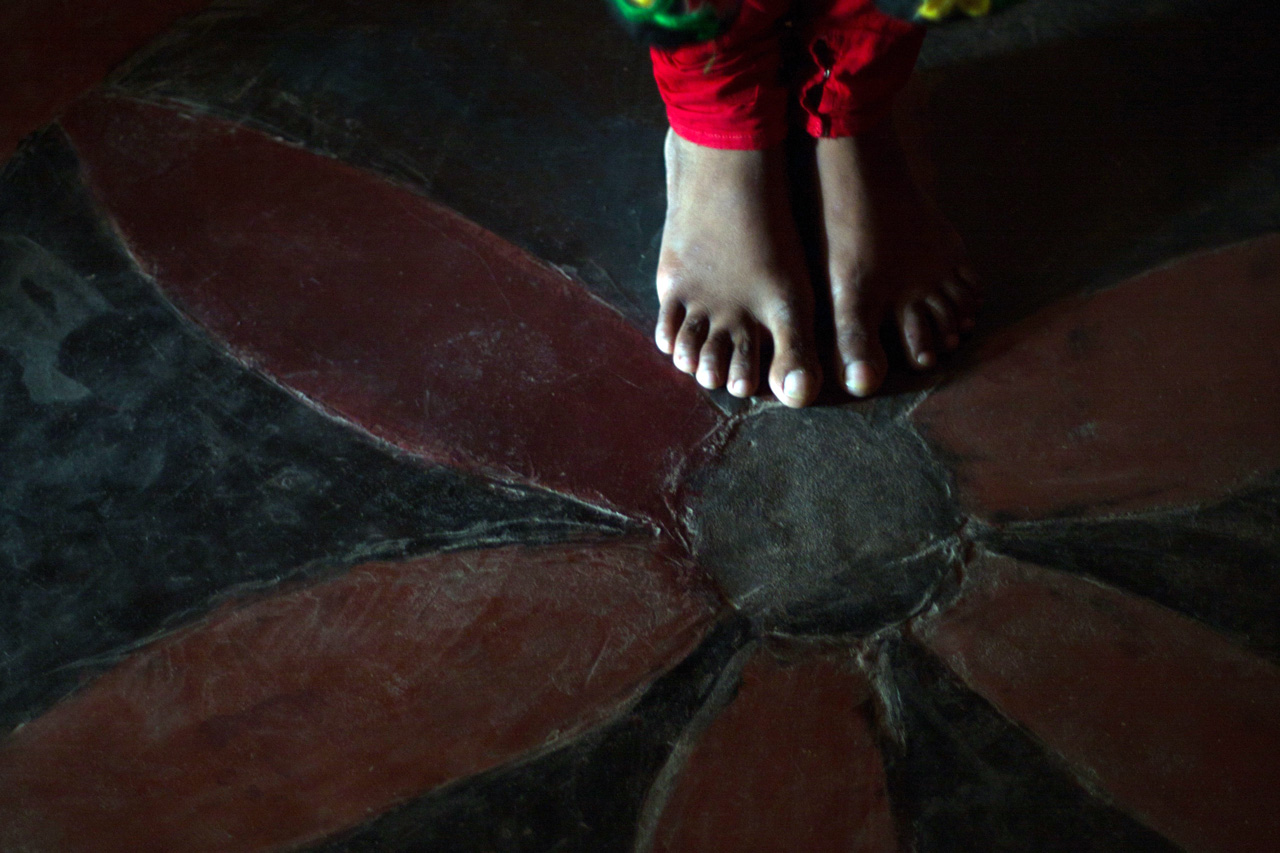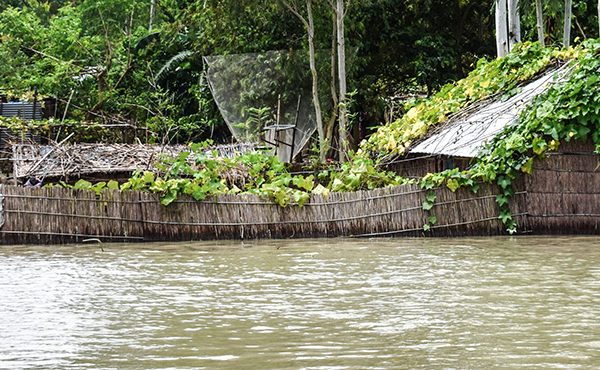Women in coastal Bangladesh are losing their uteruses to the climate crisis
Reading Time: 5 minutes
Water is life – except when that water is slowly killing you. This is the reality for millions of women in coastal Bangladesh who are subjected to reproductive health issues due to rising sea levels.
On a crisp September morning 14 years ago, I climbed down the riverbank with my fishing net and stepped into the water like I did every day. The familiar burning and itching greeted my skin as I dipped into the murky water of the Pashur river in Mongla, southwestern Bangladesh.
The water was cleaner here even just two years ago, when I married my husband and moved to live with him here in his hometown – the tiny fishing village of Chilabazar. In the two years following the move, I gave birth to a son, and got used to the life of a fisherman’s wife – which meant spending 8-10 hours neck-deep in the river to catch fish.
I held on to the fishing net with all my might and walked along the riverbed, only my hands and my head visible above the water. It was getting harder to find fish, and the only thought in my mind was that I needed to catch enough to make BDT 50 (USD 0.46) to buy rice for dinner.

Women in coastal Bangladesh are losing their reproductive rights to the climate crisis. © BRAC 2020
Suddenly I felt something unusual. I reached down. Something was sticking out between my legs. I screamed – and fainted.
My sister and mother-in-law ran over, grabbed me by my arms and legs and dragged me up the riverbank, and into the back of a battery-powered auto rickshaw. We drove to the nearest jetty, and travelled by launch (ship) for two hours to reach the nearby public health facility, 40 kilometres away. The doctor diagnosed me with a prolapsed uterus.
I spent the next few months taking medication for it, at a cost of BDT 10,000 (USD 90) – a small fortune that I was lucky enough to be able to borrow from relatives.
It has been 14 years since that morning. Not a lot has changed. Medical help is expensive. We have now sold our fishing boat to afford my treatment. I had another baby, a daughter, eight years ago. The last time I saw a doctor, they told me that I need to undergo a hysterectomy if I want to live. I have an infection in my uterus, and it is likely to turn cancerous. The procedure will cost approximately BDT 50,000 (almost USD 500), 500 times our family’s daily income. We cannot afford it. I still go fishing every day.
The doctor asked me to use pads and wash myself with clean water during my period – but there’s no option to do that. We travel miles just so we can collect a small amount to drink.
My neighbour also developed an infection in her uterus after spending years in saline water catching fish. The infection turned cancerous within a few months, and she couldn’t afford the treatment. I watched her health slowly deteriorate, until she was a ghost of her former self. Towards the end, she bled constantly. She passed away after two years of suffering. I don’t want to meet the same fate.
A brief history of water in southwestern Bangladesh
Approximately 30 million people in Bangladesh live along the coast. Here, the rivers flow through a wide and muddy plain, their channels spread across the land like a mesh net, with the lines between land and water always mutating. There are no borders that divide fresh water from the sea. Everyday, like clockwork, the tides reach a few kilometres inland, inundating coastlines and bringing the saltwater in, then retract a few hours later. For generations, people have lived in harmony with the water, tuning their lives and livelihoods with the ebb and flow of the river tides.
Until the sea levels started rising – and, with them, the salinity levels in the rivers.
20% of the total land in Bangladesh is coastal, over half of which is affected by varying degrees of salinity. Salinity intrusion is seasonal, with minimum salinity during the rainy season (June-September), and maximum in the dry season (March-May).

Salinity is so severe in some areas of coastal Bangladesh that even deep tube wells pump saltwater. © Munem Wasif 2018
In Chilabazar, where Rini Begum lives, salinity is so severe that even ponds and deep tube wells – installed at approximately 500-750 feet underground – pump saltwater.
There are two large ponds that provide fresh water for the entire village – of approximately 2,000 people. Women and children line up with jerry cans once every week to collect water from the ponds, which are revered by all to the point where nobody even dips their toes in that water, let alone bathes or washes in them.
The water they collect must last an entire week. Using them for washing dishes or clothes, or cooking or bathing, means less water for the family to drink. Compelled by this shortage of clean water, women and girls – who typically use old rags during their periods – are forced to wash using the saline water from the rivers. Doing so for years exposes them to reproductive health problems such as uterine prolapse, uterine cancer, chronic gastrointestinal problems, and skin diseases.

Women in fishing communities have to travel 30-40 km by vans, autorickshaw, and trawlers to access medical attention. © BRAC 2018
The scenario in Chilabazar is a common occurrence in the villages along the coastal belt, where women are more vulnerable and experience more problems during menstruation and pregnancy and postnatal periods, resulting in higher rates of miscarriage and child mortality. Proper medical care is inaccessible and unaffordable in these tiny fishing communities.
The problem is becoming more acute as salinity continues to increase, to the point where young girls in coastal Bangladesh are taking birth control pills to stop their menstrual cycles, and women in their 30s are undergoing voluntary hysterectomies just to stay alive. And those options are only available to the few women who can afford them.
Those who cannot afford a hysterectomy suffer a slow, painful death over the course of a few years.
The cost of surgery, treatment, medication and aftercare can be up to USD 500. The average daily income in these communities is usually USD 1-3. People prefer going to public health facilities in either Bagerhat or Khulna (40-50 km away) rather than in Mongla, despite the travel cost being higher than their daily average income, because of the quality of service available. Some families, like Rini’s, have to resort to selling their only assets, and their source of livelihood – usually fishing boats – to access the life-saving healthcare.
In Bangladesh, approximately 1.056 million hectares (2.6 million acres) — an area roughly the size of Lebanon — of arable lands are affected by salinity. People in Mongla have always had to deal with high salinity for roughly half of every year, but sea level rise is leading to high salinity for almost nine months a year now, leaving a window of just three months during monsoon to consume and store water with low salinity. That window is shrinking each year.
Climate impacts are affecting us all, but we have very different levels of vulnerability. For women who are already living in poverty, struggling to access clean water and with limited access to healthcare, it means losing your uterus at 30 years old. While women like Rini have hardly consumed or enjoyed any benefits of fossil fuels in her life, she is paying a steep price for other’s choices.
A rainwater harvesting system costs $350. We know how to adapt, the funding doesn’t. Developing countries are getting 3% of the funding they need, and 6% of projects are locally-led.
[Editor’s note: Rini Begum’s name has been changed to protect her privacy]
BRAC has half a century of experience working with people and communities on the frontlines of climate change. Our primary focus is supporting communities to adapt to the climate crisis, through locally-led climate adaptation initiatives spanning areas such as climate-resilient agriculture, housing, access to safe water, crop insurance and climate forecasting. Our operations have a low carbon footprint, but we have also been strengthening mitigation efforts, particularly focusing on nature-based climate mitigation, across all our work. More broadly, we are also shifting all of our existing programming to ensure it is climate resilient, and to take into account the effect that the climate crisis will increasingly have on every aspect of development.
Bangladesh is an example that climate adaptation can work, but it needs to be better financed and better implemented. Three principles are crucial – that adaptation is a nexus of development-humanitarian-climate programming, that special attention is given to the most vulnerable communities and that adaptation is locally-led.
Rini Begum is a fisher from Mongla, southwestern Bangladesh. Her story is told by Miftahul Jannat Chowdhury, a Content Specialist at BRAC Communications.

Learn more about The Good Feed.
Contact us at thegoodfeed@brac.net.
© 2024 BRAC




